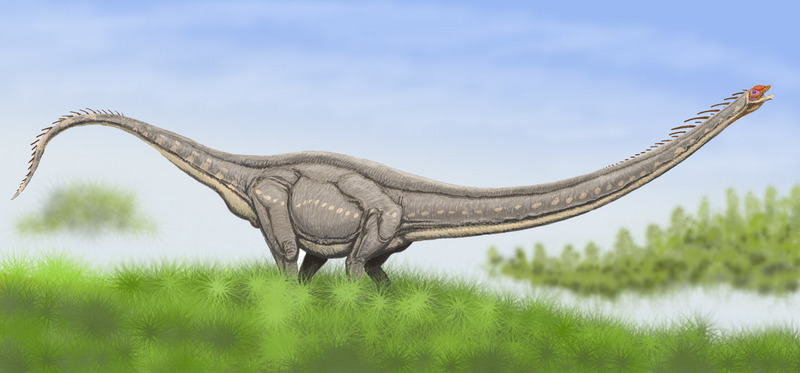|
Mamenchisaurus - Wiki
| 제목: | Mamenchisaurus - Wiki
| |

| 해상도: 1772x827
파일크기: 206955 Bytes
촬영일: 2005:10:10 20:26:22
등록시간: 2007:08:17 00:17:28
|
Mamenchisaurus
From Wikipedia, the free encyclopedia
Mamenchisaurus (pronounced mah-MEN-chee-SAW-rus; IPA: [ma??m??nt??????s??ːr??s]) was a plant-eating four-legged dinosaur, known for its remarkably long neck. Most species lived 145 to 150 million years ago, in the Tithonian age of the late Jurassic Period.
Discoveries
Mamenchisaurus was first discovered in 1952 on a highway construction site in Sichuan, China. The partial skeleton fossil was then studied, and named in 1954, by the renowned Chinese paleontologist Professor C. C. Young.
The first specimen discovered (the type specimen) was 22 meters (72 feet) long and half of that was neck (11 meters, or 36 feet), which made it the longest known neck of any animal at the time. 19 vertebrae were discovered (another record), along with long rods that were found in the neck. It is thought that adults could average up to 82 ft. long.
In 1987, a different species of Mamenchisaurus was discovered (M. hochuanensis) with a neck that might have reached up to 15 meters (49 feet) in length. In 1994, the Sauroposeidon was discovered in the United States, with a neck estimated to be up to 12 meters (39 feet) long, although, since the Sauroposeidon is a brachiosaurid, with very long forelimbs, it is a much taller dinosaur.
In 1993, M. sinocanadorum was described, this species possessed the longest cervical rib of any described sauropod dinosaur measuring 4100 mm. This longer than the longest Sauroposeidon cervical rib which measures 3420mm.
Naming
Mamenchisaurus means 'Mamenchi lizard', from the Chinese Pinyin m?? (??? 'horse') and m??n (??? 'gate'), while chi is a transliteration of x?? (溪 'stream' or 'brook'), combined with the suffix -saurus (from Greek sauros meaning 'lizard').
It was intended to name the reptile after the place where its fossil was first found ??? a construction site next to the M??m??ngx?? (??????溪) Ferry Crossing by the Jinsha River (金沙江, the westernmost major headwater stream of the Yangtze River), near Yibin (宜???) in Sichuan Province of China. However, due to an accentual mix-up by Young, the location name M??m??ngx?? (??????溪 'horse-neighing brook') was mistaken as M??m??nx?? (??????溪 'horse-gate brook').
The fact that the first Mamenchisaurus fossil was excavated from a construction site led to Young's naming the type species as Mamenchisaurus constructus.
Species
M. anyuensis He, Yang, Cai, Li & Liu, 1996
M. constructus Young, 1954: (Type species) The holotype specimen, represented by a partial skeleton.
?M. fuxiensis Hou, Zhao & Chu, 1976: Partial skeleton, include parts of a skull. It was originally named Zigongosaurus, and may be a different genus.
M. hochuanensis Young & Zhao, 1972: Four partial skeletons.
M. sinocanadorum D. Russell & Zheng, 1994: Partial skull, isolated bones. It may have been the largest, up to 26 meters (85 feet) in length.
M. youngi Pi, Ouyang & Ye, 1996: Mamenchisaurus youngi (pronunciation YOUNG-eye) was unearthed in Xinmin County, Zigong City in Sichuan Province, China, in 1989. The fossil specimen, 16 meters long with a 6.5-meter neck, is relatively small among various species of Mamenchisaurus. The species was named in honour of Young.
Popular Culture
Mamenchisaurs were featured in the roundup scene in Jurassic Park's sequel, The Lost World: Jurassic Park.
A Mamenchisaurus featured in a travelling Dinosaurs from China which toured Australia in 2002.
http://en.wikipedia.org/wiki/Mamenchisaurus
| The text in this page is based on the copyrighted Wikipedia article shown in above URL. It is used under the GNU Free Documentation License. You may redistribute it, verbatim or modified, providing that you comply with the terms of the GFDL. |
|
댓글 |
|---|
| | kiara |
|
| this article is messed up by someone editing it |
^o^
동물그림창고 똑똑전화 누리집
^o^
|
|
|